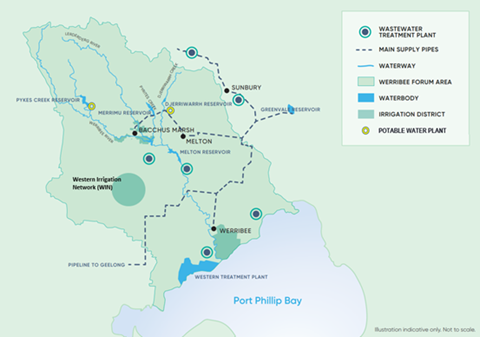A masterplan for improving future water use in the Werribee catchment
The Werribee Integrated Water Management Forum is investigating the feasibility of a reconfiguration of the Werribee water supply system to provide more climate-resilient water sources for non-drinking purposes, thus making better use of all sources of water and reservoirs in the local system.
The Werribee catchment is the driest in Southern Victoria and is facing numerous challenges to water security due to drier conditions that have resulted in reduced river flows, contributed to higher salinity in the Werribee River and reduced water reliability and quality for downstream reaches and irrigation districts. The catchment is also experiencing fast population growth, which will increase water demand and increase the generation of alternative water sources such as recycled water or stormwater.
The Werribee River is a vital part of Country for Traditional Owners including the Bunurong, Wurundjeri Woi-wurrung and Wadawarrung peoples. However, Traditional Owners do not currently hold any water entitlements. The Werribee system supports platypus and a range of native fish, frog, bird and waterbug species. The freshwater-saltwater interface of the Werribee River estuary is a regionally significant ecosystem due to the many aquatic plants and animals it supports. There is currently a significant shortfall in the amount of water available to support these key environmental values, and this shortfall is predicted to increase and harm these environmental values along the Werribee River. The Werribee catchment also includes significant areas of agricultural production such as the Werribee and Bacchus Marsh irrigation districts. Recycled water is already a significant source for the Werribee Irrigation District, but greater use of recycled water and stormwater could help increase irrigation water security and reliability and support irrigated agricultural production and expansion in peri-urban areas.
There is a unique opportunity to rethink water management in the Werribee catchment. The masterplan is examining all water demands (irrigation, environment, Traditional Owners, and urban) and how all sources of water in the catchment (river water, recycled water, and stormwater) can meet these demands over the long-term. Ultimately, the project could boost supplies for the environment and Traditional Owners, support long-term resilience of Victoria’s water system by reducing reliance on river water extractions, and reduce the discharge of wastewater to Port Phillip Bay.
This project is Action 11 in the Werribee Integrated Water Management Forum’s Strategic Directions Statement.
Themes and Local Areas
| Primary Theme: | Water Supply and Use |
| Other Themes: | Waterways, Sustainable Agriculture, Marine Environments, Traditional Owners and Aboriginal Victorians, Communities, Climate Change |
| Primary Local Area: | Moorabool, Melton, Wyndham & Greater Geelong |
| Other Local Areas: | Urban Melbourne |
| Project location: | Werribee catchment |
| Scale of the project: | Landscape |
| New or continuing work: | New work |
Project partners
| Lead organisation: | Greater Western Water |
| Key partners: | Department of Energy, Environment and Climate Change (DEECA), Melbourne Water, Southern Rural Water, City of Melton, Shire of Moorabool, Wyndham City Council |
| Registered Aboriginal Party/s relevant to the project or its area: | Bunurong Land Council Aboriginal Corporation, Wadawurrung Traditional Owners Aboriginal Corporation, Wurundjeri Woi-wurrung Cultural Heritage Aboriginal Corporation |
Investment opportunities
| Opportunities for investors within this project start from: | $$$ (Hundreds of thousands of dollars) |
| Estimated scale of investment for full project implementation: | $$$$ (Millions of dollars) |
| Estimated timeframe for full project implementation: | 10+ years |
Contribution toward targets
| Primary Regional Catchment Strategy target: | 1.1 Water supply and use – redistributing water supply across the catchment to enable fit-for-purpose water for all demands, including alternative water for irrigation purposes. 1.2 Water for the environment – Increase in the volume of water allocated to the environmental water reservice to improve waterway health. 1.3 Water for Traditional Owners – Increase Traditional Owner water entitlements in the catchment. 1.4 Water for agriculture – Provide reliable, fit-for-purpose water for agriculture. |
| Relevant Biodiversity 2037 goal: | – |
| Relevant National Landcare Program priority: | – |
More information
This work is part of the program being coordinated by the Werribee Integrated Water Management Forum. https://www.water.vic.gov.au/liveable/integrated-water-management-program/forums



